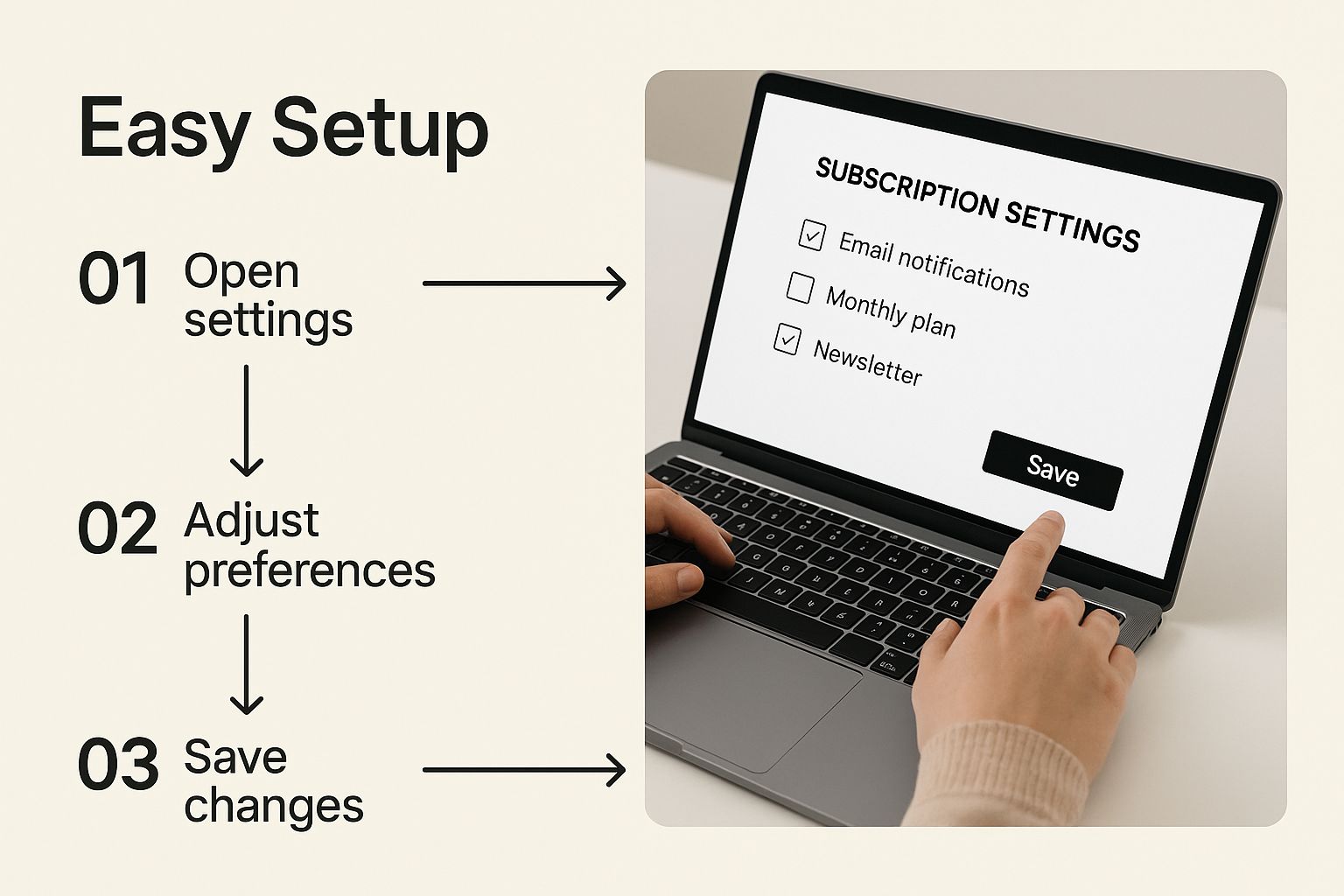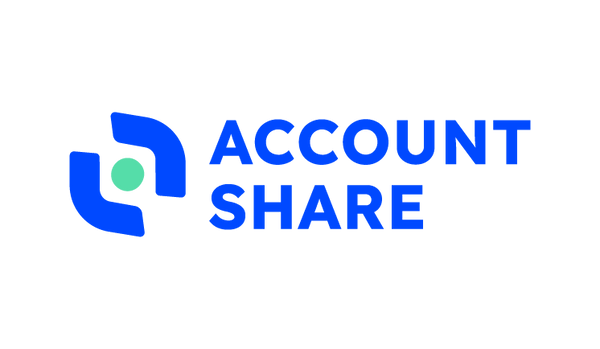
Shared Subscriptions: Save Money on Streaming & More
Share
Tired of watching your monthly bills for streaming, software, and delivery services stack up? You're not the only one. The reality is, shared subscriptions have become a brilliant way to slash those costs and get more bang for your buck. Think of it like chipping in with roommates for a much nicer apartment than you could afford on your own.
The Rise of Shared Subscriptions
If you’ve ever gone in on a music plan with friends or juggled multiple video streaming accounts for your family, you're already practicing the core concept of account sharing. It’s a simple, common-sense answer to a very modern problem: the endless list of services that want a piece of your monthly budget. What started as a quiet little hack has exploded into a mainstream financial strategy for millions.
The reason behind it is pretty straightforward. As our entertainment, work tools, and even daily errands shift to subscription models, the individual costs add up fast. Sharing accounts offers a direct route to making it all affordable.
Before we dive deeper, let's get a quick overview. This table breaks down the essential aspects of sharing subscriptions.
Quick Guide to Shared Subscriptions
| Aspect | Description |
|---|---|
| What It Is | The practice of multiple people pooling money to pay for a single subscription plan, like a family or group account. |
| Primary Benefit | Significant cost savings. Everyone pays a fraction of the full price while enjoying premium access. |
| Common Platforms | Streaming services (Netflix, Spotify), software suites (Microsoft 365), and delivery apps (Amazon Prime). |
| Key Consideration | Trust and clear communication are crucial. Only share with people you know well. |
| Potential Risks | Security vulnerabilities if passwords are handled poorly, and potential violation of a service's terms. |
This table is just the starting point. Understanding the why behind this trend is key to mastering it.
Why Sharing Is More Popular Than Ever
This isn't a random fad; it's a direct reaction to some huge shifts in how we buy things. The global subscription economy was recently valued at around USD 487 billion, but it’s expected to balloon to an eye-popping USD 2.13 trillion by 2034. The content category—which covers everything from video and music to software—is the biggest driver, accounting for nearly 45% of that entire market. You can get the full scoop on these numbers and what they mean for your wallet over at market.us.
That kind of explosive growth means more companies are fighting for your attention and your money, which makes sharing less of a choice and more of a necessity. The main reasons people are jumping on board are:
- Financial Reality: Let's be honest, for many—from students watching every penny to families balancing a household budget—pooling resources is the only practical way to access premium services.
- More for Less: Sharing opens up a whole universe of content and tools that would be tough to justify paying for all by yourself. Suddenly, you have access to multiple libraries and platforms.
- A New Way to Connect: It's also become a social activity. Sharing an account can mean binge-watching a new show with a friend who lives miles away or collaborating on a project using the same software.
At its core, the shared subscription model is just collaborative consumption. It takes what was once a personal expense and turns it into a group asset, creating value for everyone involved without emptying their pockets.
This guide is here to walk you through it all. We'll get into the nitty-gritty of how to share accounts securely, handle group payments without any awkwardness, and stay on the right side of the rules. It's time to turn a smart idea into a smooth, everyday practice.
Weighing the Benefits and Risks of Sharing

While saving money is the most obvious reason to share subscriptions, the real benefits go much deeper. But let's be honest, so do the risks. Getting this balance right is the secret to sharing accounts without the headaches.
Think of a shared account like having a community library card instead of buying every single book yourself. Suddenly, you have access to a massive world of content and tools that might be too expensive to justify on your own. This isn't just about entertainment, either. It’s about creating shared experiences, like binging a new series with family members across the country or collaborating on a project with teammates using the same high-end software.
The Clear Advantages of Pooling Resources
When managed well, the upsides of a shared subscription are pretty hard to ignore. Beyond the instant financial relief, sharing can genuinely improve your digital life.
- Expanded Access: You can instantly grow your library of movies, music, software, and news without your monthly budget taking a hit.
- Simplified Management for Families: Let's face it, one family plan is so much easier to track than juggling multiple individual accounts and payment dates.
- Shared Social Experiences: Sharing gives you common ground for connection. It could be discussing a show you’re all watching or learning a new skill together on an educational platform.
For a lot of people, these perks turn premium services from a "nice-to-have" luxury into an accessible, everyday tool. It’s a smarter, more collective way to get more value for everyone in the group.
Sharing a subscription is fundamentally an act of trust. You aren't just sharing access to a service; you're handing over a digital key that could potentially unlock personal information and payment methods.
This brings us to the other side of the coin. Handing over that digital key without thinking it through can open you up to some serious risks. It's vital to know the potential downsides before you start inviting people into your accounts.
Navigating the Potential Downsides
Just like you wouldn't lend your house key to a total stranger, sharing a password requires you to be careful about who you trust. The biggest risks aren't just technical; they're deeply personal.
A major concern is privacy. When you share an account, you might also be sharing your watch history, saved items, and personalized recommendations. Without separate profiles, your digital space can get messy fast. An even bigger risk is the chance of unauthorized purchases. If your credit card is linked to the account, a less-than-honest group member could go on a spending spree, turning your money-saving plan into a financial nightmare.
Finally, you have to consider the service's Terms of Use. Many companies are cracking down on password sharing. For instance, Disney+ now offers an "Extra Member" add-on for a fee, making it clear that standard plans are meant for a single household. Breaking these rules could lead to a warning or, in a worst-case scenario, getting your account suspended. Keeping these rules in mind is key to a smooth, uninterrupted experience. The goal is to make sharing work for you, not against you.
How Different Groups Share Subscriptions
The idea of a shared subscription really clicks when you see how different people put it into practice. A family sharing Netflix is playing a completely different game than a group of freelancers sharing a project management tool. Looking at these real-world examples shows just how flexible and valuable pooling resources can be.
Each group has its own reasons for sharing, its own benefits, and, of course, its own set of challenges. A family might be all about content filters, while a small business is focused squarely on data security. The strategy changes with the situation, which helps you see how this advice applies directly to your life.
For Families Managing Entertainment and Education
For most families, running a household these days also means juggling a dozen different subscriptions. Sharing accounts isn't just a clever way to save a few bucks; it’s become a core part of keeping everything organized. Think about it: a single family plan for a streaming service simplifies life, letting parents set up separate profiles for each kid with specific content restrictions.
And it goes way beyond just movies and TV shows. Families are often sharing:
- Educational Platforms: One subscription to a learning app can give all the kids in the house access to valuable study aids.
- Music Streaming: A family plan means no more fighting over who gets to play their music. Everyone gets their own private playlists and recommendations.
- Gaming Services: Services like Xbox Game Pass or PlayStation Plus often have sharing features that open up a massive library of games for the whole family.
The main challenge here, without a doubt, is content control and safety. It's on the parents to be diligent about setting up and maintaining those parental controls and profiles. This ensures kids are only seeing, hearing, and playing things that are right for their age.
For a family, sharing is about more than just the cost. The subscription becomes a central hub for entertainment and learning, all streamlined under one payment and managed with safety as the top priority.
For Students on a Tight Budget
When you're a student, every dollar matters. The cost of software for school, access to research databases, and even just a way to unwind can add up fast, creating a real financial strain. For many, shared subscriptions are a lifeline that makes essential tools—and a much-needed study break—actually affordable.
It's incredibly common for a group of roommates or classmates to pool their money for things like:
- Productivity and Creative Software: Splitting the cost of expensive suites like Adobe Creative Cloud or Microsoft 365 is a classic student move.
- Streaming and Music Services: After a long night of hitting the books, entertainment is a must. Sharing the cost makes it possible.
- Niche Academic Tools: Some specialized research software costs a fortune, and group access is often the only way students can get their hands on it.
The biggest hurdle for students? Coordination and trust. You have to set clear, upfront rules about who pays when and how passwords are handled. Without that, you're just asking for drama.
For Freelancers and Small Teams
In the business world, high overhead can sink a new venture before it even gets started. Freelancers and small teams have gotten smart about using shared subscriptions to get their hands on powerful tools without signing pricey enterprise contracts. This is how they punch above their weight, using the same professional software as the big guys.
Some of the most popular shared tools include:
- Project Management Platforms: One subscription can keep an entire team organized, on the same page, and hitting their deadlines.
- Design and Marketing Software: Access to top-tier design tools or SEO platforms gives a small team a huge professional advantage.
- AI Assistants: By sharing a premium AI tool like ChatGPT Plus, a team can collectively supercharge its productivity and creativity.
For this group, the top concerns are security and professional separation. It is absolutely critical to make sure client data stays under lock and key and that personal browsing doesn't cross over into professional work. Using tools that allow for different user permissions is a key piece of making this work smoothly and securely.
Your Playbook for Safe Subscription Sharing
Jumping into a shared subscription is a fantastic way to save money, but the key to making it work long-term is having a simple, clear game plan. This isn't about complicated tech wizardry; it's really just about smart habits and honest communication. With the right approach, you can sidestep the common pitfalls and make sharing a secure, seamless experience for everyone involved.
The absolute first place to start is with your passwords. Let's be honest, reusing the same password for everything is a huge security no-no. Your best defense is to create a strong, unique password for every single subscription account you share.
I know, that sounds like a headache to keep track of. That's where a good password manager comes in. These tools are lifesavers—they generate and securely store complex passwords for you. Instead of handing out the actual password, you can grant access through the manager, acting as a digital gatekeeper for your accounts.
Establish Clear Ground Rules
Beyond just passwords, a solid foundation for any sharing group is a set of clear, agreed-upon rules. This simple step heads off misunderstandings before they can even start, protecting everyone's privacy and financial contributions. Think of it as a friendly handshake agreement that keeps things fair and square.
Here’s what your group should agree on from day one:
- Set Up Individual Profiles: Nearly every service, from Netflix to Microsoft 365, lets you create separate user profiles. Make this your first action item. It keeps recommendations, watch history, and personal files completely separate, giving everyone their own private corner of the account.
- Create a Payment System: Figure out the money part upfront. The simplest way is for one person to manage the primary payment and have everyone else reimburse them through an app like Venmo or Zelle. This keeps things transparent and avoids awkward "who owes what" conversations down the line.
- Agree on Usage Limits: Be crystal clear about who is officially in the sharing circle. Agree that no one shares the login details with friends or family outside the group. This prevents the account from getting flagged for too many users, which could get it suspended.
This image gives you a quick look at how easy it is to set these things up.

As you can see, most platforms make it pretty intuitive to configure user profiles and manage the core settings for your group.
Account Sharing Safety Checklist
To make things even easier, here's a quick checklist. Running through these steps before and during your sharing arrangement is the best way to ensure everything stays secure and everyone remains happy.
| Safety Step | Why It Matters | How to Do It |
|---|---|---|
| Use a Password Manager | Prevents direct password exposure and makes access management simple and secure. | Use a trusted password manager to create a unique password for the service and share access through the app. |
| Set Up Separate Profiles | Protects individual privacy, history, and recommendations for all users. | As soon as the account is active, have every member create and personalize their own user profile. |
| Establish a Payment Plan | Avoids confusion and ensures the account owner is reimbursed fairly and on time. | Choose a payment app (Venmo, Zelle, etc.) and a recurring date for everyone to send their share. |
| Limit Sharing | Prevents account suspension from overuse and keeps access within the trusted group. | Agree as a group that the login credentials will not be shared with anyone outside the original members. |
| Review Account Activity | Allows you to quickly spot and shut down any unauthorized access. | Once a month, the account owner should glance at the "devices" or "activity" log in the account settings. |
Following this checklist is a simple but powerful way to build trust and maintain a healthy sharing dynamic from the start.
Practice Proactive Account Management
Once your sharing circle is up and running, a little bit of ongoing attention is all it takes to keep things on track. Staying proactive means you can catch small issues before they snowball into big headaches.
A shared subscription is a living arrangement. Just like a shared living space, it requires occasional check-ins to ensure everything is running smoothly and everyone feels respected and secure.
Make it a habit to periodically review the account's activity log. It's an easy way to spot any strange logins or devices you don't recognize. If something looks off, you can immediately change the password and give your group a heads-up. For more great ideas on this, check out these subscription sharing tips to save money with easy strategies.
Ultimately, these simple, proactive steps are what build trust and ensure your sharing group is a win-win for years to come.
The Evolving Future of Account Sharing
The world of shared subscriptions is always on the move. It’s a constant tug-of-war between companies trying to protect their revenue and all of us looking for affordable ways to access the services we love. For years, sharing was the unofficial norm, but the game is changing. This isn't the end of sharing—it's just the next chapter.
The biggest shift we're seeing is the crackdown on casual password swapping. Companies are no longer just looking the other way. Instead, they're rolling out official, paid solutions and getting much stricter with household verification to figure out who's logging in from the couch and who's across town.
The Rise of Paid Sharing and New Platforms
Big-name streaming services have started offering "extra member" slots. This lets you officially add someone outside your household to your plan for a small fee. It’s a smart move on their part—a direct response to lost revenue that finds a middle ground, legalizing sharing while bringing in more cash.
Of course, this changes things for a lot of sharing groups. To get a handle on how this all works, it’s worth looking into whether a Netflix account can be shared under these new policies and what the best strategies are.
This evolving market has also opened the door for better management tools. Platforms like AccountShare are stepping in to help people navigate these new shared subscriptions legally and securely. They take the headache out of splitting costs and managing who has access, making the whole process transparent and fair for everyone.
The subscription economy isn't just growing; it's becoming a dominant force in global commerce. By adapting to sharing behaviors, companies are tapping into a powerful engine for both user acquisition and long-term loyalty.
This trend highlights just how massive the subscription model has become. In fact, the digital subscription economy is on track to be worth an incredible USD 3 trillion by 2025. This explosion is driven by companies that have figured out the power of recurring revenue. Just look at the numbers: firms in the Subscription Economy Index grew 3.4 times faster than those in the S&P 500 between 2012 and 2024. As you can see from more subscription statistics, embracing shared models is a key part of this success.
Ultimately, the future of account sharing comes down to one thing: adaptation. By keeping up with how companies are changing their rules and using new platforms built for safe sharing, you can keep enjoying all the benefits of pooling your resources. It’s all about having a forward-looking strategy that works for the long haul.
Sharing Beyond Streaming Services

When most people hear “shared subscriptions,” their minds usually jump straight to Netflix, Hulu, or maybe Spotify. And sure, those are the classics. But the reality is, the world of sharing has exploded well beyond our TV screens and music playlists.
It turns out that the basic appeal of sharing—getting more value, better access, and a sense of community—isn't just a digital thing. It’s now shaping how we get everything from our weeknight dinners to our daily news.
The Subscription Box Boom
One of the coolest places we’re seeing this happen is with subscription boxes. Think about it: meal kits, beauty products, pet toys, even curated clothing boxes arriving right at your doorstep. This isn't a niche market anymore.
The subscription box industry is already valued at an estimated USD 37.5 billion, and experts predict it could skyrocket to USD 116.2 billion by 2033. You can dig into the numbers in these subscription box market findings. Many of these services are designed for sharing from the get-go, with family-sized plans or group options that make it easy to split the goodies and the cost.
The success of group-friendly subscription boxes shows that the desire for shared value isn't limited to digital access. It’s a powerful consumer behavior that applies just as strongly to tangible, everyday products.
New Frontiers for Shared Access
And it doesn't stop with physical goods. The sharing model is making serious inroads into other digital services that were once walled off, opening up new ways to access premium content without the premium price tag.
We're seeing a huge uptick in shared subscriptions for things like:
- News and Publications: Top-tier news sites often have group or corporate plans, letting a whole team or family stay in the know under a single membership.
- Educational Platforms: Students and professionals are teaming up to share access to online course libraries and skill-building sites, making continuous learning much more affordable.
- Gaming Services: It's common for console and PC gaming subscriptions to have family-sharing features that unlock huge libraries of games for everyone in the house to play.
The bottom line? The smart strategies we learned to manage streaming subscriptions are now being used everywhere. It just goes to show how essential and flexible this trend has become in our daily lives.
Got Questions About Shared Subscriptions? Let's Clear Them Up.
Even with the best intentions, diving into shared subscriptions can bring up a few tricky questions. It's totally normal. Getting the details right on the legal, financial, and personal fronts is what makes sharing work smoothly. Let's tackle some of the most common concerns head-on.
Is Sharing My Subscription Password Actually Legal?
Here's the deal: sharing your password isn't illegal in the sense that you'll get arrested, but it almost always breaks the service's Terms of Service (ToS) if you share it outside your household. The real risk? Your account could get flagged, suspended, or even permanently shut down.
To stay in the clear, your best bet is to use the official sharing features platforms have started offering.
- Family Plans: These are designed specifically for people living under the same roof, usually giving everyone their own profile.
- Extra Member Slots: Services like Disney+ are now rolling out options to pay a little extra to officially add someone from another household.
Using these built-in tools keeps your account safe and ensures you're playing by the rules.
What’s the Easiest Way to Handle Payments with a Group?
Money can make things awkward, so it's best to keep it simple. Have one person act as the "account owner" who pays the main bill each month. Everyone else can then send their share using a digital payment app like Venmo, PayPal, or Zelle. This creates a nice, clean paper trail.
The secret to avoiding chasing people for money is automation. Set up recurring monthly payment requests or reminders. This takes the pressure off the account owner and ensures everyone pays on time, every time.
What if Someone in the Group Misuses the Account?
If you spot strange activity, like purchases you didn't make, or find out someone shared the password with a non-member, you need to act quickly. First, have a direct and honest conversation with the person involved. Gently remind them of the ground rules you all agreed to when you started the group.
If the behavior doesn't stop, your priority shifts to protecting the account. Don't hesitate. Change the password immediately and remove the person from the group. It might feel harsh, but it's the only way to secure your account and prevent bigger problems down the line.
Ready to make sharing subscriptions simple and secure? AccountShare removes the guesswork and hassle from managing your groups. We automate payments, manage permissions, and keep everything secure so you can just enjoy the savings. See how AccountShare can help you.
